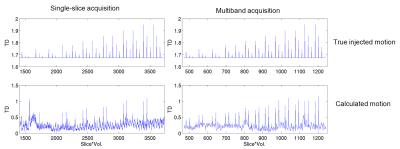1630
Validation of Motion Correction with Multiband SLOMOCO using Multiband SimPACE1The Cleveland Clinic, Cleveland, OH, United States
Synopsis
A Multiband version of the SimPACE sequence was developed to validate multiband SLOMOCO motion correction method. With the increasing use of simultaneous multi-slice acquisition techniques to acquire fMRI data more efficiently, the traditional motion correction methods need to be modified or improved to better correct subject motion in fMRI. This preliminary study showed that multiband SLOMOCO can detect the outermost slice motion better than single-slice SLOMOCO. Multiband SimPACE is a promising sequence to further facilitate the improvement of motion correction methods including multiband SLOMOCO.
Introduction
Although the simultaneous multi-slice acquisition technique1 has been applied in fMRI to reduce the scan time, head motion is still an important factor to be considered when fMRI data are being processed. SLOMOCO2 was developed and validated to correct slice-wise motion for BOLD MRI. It is novel in that it considers the motion can be different during each slice acquired in a volume, which overcomes the limitation of only volumetric motion being considered with most motion correction methods. When multiband acquisition is used in fMRI sequence, several slices are acquired simultaneously, which means that the motion effect of these slice are same. There is an inherent limitation of SLOMOCO in that it detects motion in the outermost slices less accurately than inner slices2. With a multiband acquisition, the outermost slice is acquired together with other slices closer to the central slice. By utilizing this fact, we expect to improve the motion detection in the outermost slices. Therefore, a new version of SLOMOCO (multiband SLOMOCO) was developed to correct motion in multiband acquisitions. We hypothesized that multiband SLOMOCO method will outperform the single-slice SLOMOCO method in detecting motion in the outermost slice.Methods
A Multiband SimPACE sequence2 was developed to acquire BOLD data with injected motion simultaneously on multiple slices (multiband factor=3) from two male healthy volunteers with an IRB approved protocol on a 7T MRI scanner (MAGNETOM 7T, Siemens) using a 32-channel phased array head coil (Nova Medical). For comparison, BOLD data were also acquired with single-slice acquisition (multiband factor=1). 148 repetitions of 27 axial slices (slice thickness=2.5mm); TE/TR=21ms/2800ms; matrix, 96×96; field of view, 240mm×240mm; receive bandwidth, 2604Hz/px. Motions in x,y,z translation with the range of 0.4 mm to 1 mm were only injected to central slice (slice#14) and outermost superior slice (slice#27) for single-slice SimPACE acquisition. For multiband acquisition, slice#5 and 23 will have the same injected motion as slice#14; and slice#9 and 18 will have the same injected motion as slice#27. All the raw data were saved and reconstructed using Matlab (MATLAB R2012a, The MathWorks Inc., Natick, MA 2012). Then the multiband and single-slice BOLD data were corrected for motion effect with multiband and single-slice SLOMOCO respectively.Results
The motion parameters obtained from one subject with single-slice (left) and multiband (right) SLOMOCO shown in Fig.1. There were 6 and 7 motion events injected on central slice and outermost superior slice separately. Multiband SLOMOCO detected all 13 motion events on both slices, however, only the 6 motion events injected on the central slice were detected for single-slice SLOMOCO. This also can be see with total displacement (TD)3 (Fig.2) which is the parameter converted from all translations and rotations.Discussion
A Multiband version of the SimPACE sequence was developed to validate multiband SLOMOCO motion correction method. With the increasing use of simultaneous multi-slice acquisition techniques to acquire fMRI data more efficiently, the traditional motion correction methods need to be modified or improved to better correct subject motion in fMRI. Although z-translation was not very well detected, this preliminary study showed that multiband SLOMOCO can detect the outermost slice motion better than single-slice SLOMOCO. Multiband SimPACE is a promising sequence to further facilitate the improvement of motion correction methods including multiband SLOMOCO.Conclusion
Simple motion parameters acquired with multiband SLOMOCO were validated
with multiband SimPACE sequence. Multiband SLOMOCO performs better than
single-slice SLOMOCO in detecting outermost slice. Future work will involve
validation of a broader variety of motion.Acknowledgements
The authors gratefully acknowledge technical support by Siemens Medical Solutions.References
1. Feinberg D & Setsompop K. JMR 2013; 229: 90-100.
2. Beall E & Lowe M. NeuroImage 2014; 101: 21-34.
3. Jiang et al. Hum. Brain Mapp. 1995; 3: 224-235.

